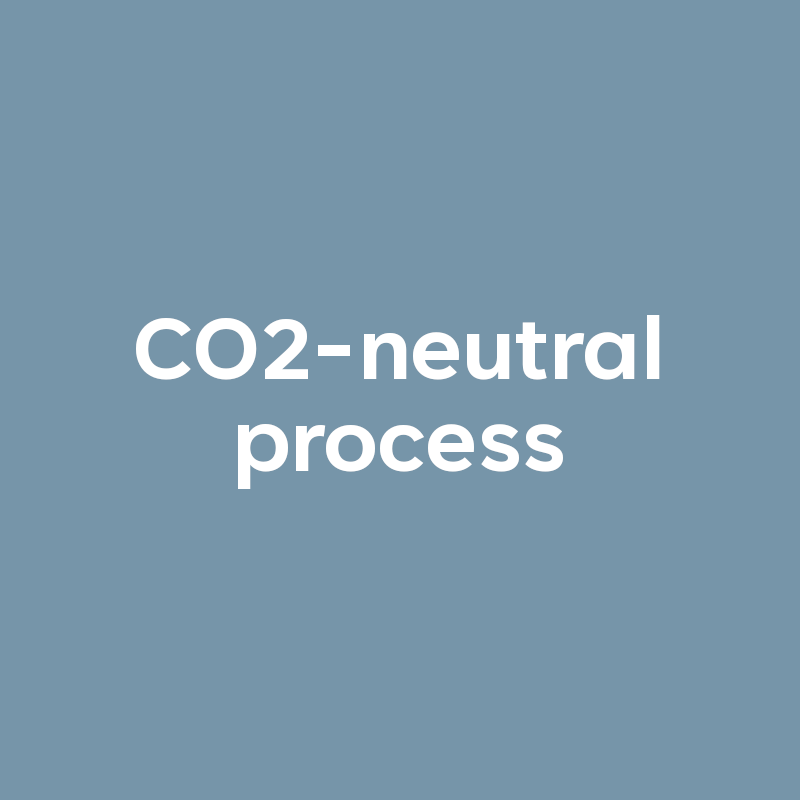Hydrogen:
Energy source of the future
Hydrogen is indispensable for decarbonization. To replace fossil fuels such as coal, oil and gas, industry and society need immense amounts of H2.
Among other energy carriers, hydrogen will provide process heat for industry, keep stationary generators running as well as power ships, heavy-duty vehicles and buses. If carbon dioxide emissions are to fall significantly, hydrogen must be produced in a climate-neutral way. The enormous demand for hydrogen exceeds production capacity.
Only climate-neutral hydrogen at competitive prices are economically reasonable. This requirement is not met today. Production costs are high. Only one percent of hydrogen is produced in a climate-neutral way and its production with the well known electrolysis process depends on electricity from renewable energy sources.
With Green Hydrogen Technology’s process, climate-neutral hydrogen can be produced on an industrial scale at competitive prices.
Smart conversion of non-recyclable materials
On a global scale, one million tons of plastic are burned or landfilled every day and plastic ends up in the environment. The incineration process produces millions of tons of CO2 every day. With its patented process, Green Hydrogen Technology has created a way to convert the plastic energetically in the form of hydrogen – emission free.
The process consists of three modules:
- Synthesis gas generation
- Synthesis gas purification
- Synthesis gas separation
The modules allow the alternative use of different raw materials. Thus, the production plant can be adapted to the available resources at site. For example, biogas or biomass, such as dried sewage sludge, as well as excess heat from production processes can be used as an energy source for hot gas production. Instead of gasifying plastic, wood dust can also be used. With its decentralized orientation, the technology does not require an elaborate infrastructure and avoids high transportation costs.
For plant construction, we are not dependent on the import of problematic resources (e.g. rare earth): All plant components can be manufactured from resources that are produced and available worldwide.
Step I: Synthesis gas generation
In the first phase, process-derived synthesis gas is combusted with oxygen to produce a hot gas of 1,500 to 1,700 degrees. Plastic is injected into the hot gas stream using Green Hydrogen Technology’s patented ChemQuench process to gasify and produce a hydrogen-containing syngas in an energy-efficient manner.
Step II: Synthesis gas purification
Ash, impurities and water is then removed from the synthesis gas. Part of the gas is then recycled for hot gas production. The ash can be used as an additive for cement production.
Step III: Synthesis gas separation
The purified syngas is refined to H2 5.0 (99.999%) by pressure swing adsorption. Green Hydrogen Technology’s production plants can produce up to 4,000 tons of climate-neutral hydrogen per year. In addition, liquid CO2 is produced, which can be used as a technical gas.
GHT-Technology
Convincing advantages

Up to now, plastic has been burned and emits CO2 or ends up as waste in the environment. Biomass rots under the formation of methane as a climate-impacting gas. Our technology converts the waste into valuable hydrogen and prevents CO2 emissions.

Our plants are made only of standard construction materials available worldwide and there are several suppliers for all key components used.

The process prevents emissions of 60k tons of CO2, which would otherwise be produced by burning 48k tons of plastic. With 3.7k tons of H2 produced also reduces 37k tons of CO2 emissions at the end user.

48k tons of plastic produce 3.8k tons of ash (minerals and heavy metals), which can be used as a raw material in the cement industry.

Local production of hydrogen close to the consumers avoids long transport distances. This avoids costs of 1.20 $/kg for distances over 10,000 km, respectively 0.6 $/kg up to 5,000 km.

We produce hydrogen at an unbeatable price, as our raw materials and energy sources used have a negative price.
FAQs
Technology
What makes GHT’s technology unique?
Green Hydrogen Technology’s production process generates hydrogen from non-recyclable waste and takes regional conditions into account. GHT technology is based on a new, patented process. It converts plastic or biomass waste into synthesis gas by gasifying it in a hot gas. The hot gas is produced from the combustion of the process’s own synthesis gas, biomass or external decoupled process heat.
The production plant can thus be adapted to the available resources of the operator. With its decentralized orientation, the technology does not require an elaborate infrastructure and avoids high transport costs
What exactly distinguishes GHT technology from hydrogen production by electrolysis?
Up to now, climate-neutral hydrogen has mostly been produced by electrolysis, where water is split into its components hydrogen and oxygen using valuable electrical energy from renewable sources.
GHT has developed a superior process to produce climate-friendly hydrogen. The advantages over other thermal-chemical processes are clear:
- High temperature leads to complete decomposition of the feedstock and thus to the greatest possible hydrogen yield
- Dioxins, furans and PCBs are also decomposed
- Avoidance of tar and soot (which is often problematic at lower gasification temperatures)
- Lower generation costs (due to raw materials with negative price)
- Reasonable use of wastes that are available in large quantities
Where does the raw material for operating a GHT plant come from?
Green Hydrogen Technology’s process relies on climate-friendly hydrogen production from plastic waste, wood waste or sewage sludge
Plastic waste
There is no sensible use for plastic waste that cannot be sent for material recycling. In Germany, this amounts to 3.8 million tons per year (source: Plastic Atlas, Bund für Umwelt und Naturschutz Deutschland, 2019).
Wood waste
Despite distinct recycling systems, a large proportion of wood waste cannot be recycled. In Germany, this amounts to 11 million tons per year (source: Technology for Wood and Natural Fiber-Based Materials).
Sewage sludge
In Germany alone, almost 1.9 million metric tons of sewage sludge are produced annually (source: Eurostat Data, 2020). From 2029, the European Union makes phosphorus recovery from sewage sludge compulsory. This is only possible to a limited extent in existing processes and is extremely costly. As an example, sewage sludge is currently added to cement plants as an alternative fuel. Green Hydrogen Technology has developed a new technology that simplifies phosphorus recovery.
What are the residuals of the plastic after it has passed through the GHT plant?
Mainly hydrogen and CO2 are produced. Ash with the main components CaO, SiO, TiO2 and Al2O3 is produced from the inorganic components. The ash is filtered and can be processed for further use.

What kind of plastic does GHT use?
GHT uses non-recyclable plastic that would otherwise end up in the ocean or landfills, causing microplastic pollution, or incinerated in plants, emitting enormous amounts of CO2.
Why is the process more environmentally friendly than other recycling methods?
The conventional thermal recycling of plastics in waste incineration plants emits enormous amounts of CO2 into the atmosphere. Since CO2 is present as a liquid product in the Green Hydrogen Technology process, these emissions can be eliminated. CO2 can already be used in various technical applications or can be sequestered as an alternative.
Economics
Why can GHT produce hydrogen at such low price?
GHT relies on waste (plastic waste, biomass or sewage sludge) as raw materials that are available free of charge or even have a negative price. In addition, the decentralized orientation of the plants limits the transport costs of the H2 to a minimum. It can be produced where H2 is needed.
How much hydrogen can a GHT plant produce in a year?
The patented technology is exceptionally efficient. GHT plants produce up to 4,000 tons of climate-friendly hydrogen per year.
Prospects and target groups
Who is the typical operator of a GHT plant?
Companies with high energy consumption: chemical industry, steel, cement or paper producers. Their decarbonization strategies require enormous amounts of climate-neutral hydrogen, which can be produced locally with GHT technology.
Chemical and industrial parks: large industrial complexes with various production sites. Green Hydrogen Technology consumes waste materials generated at site and produces CO2 and H2 as raw material and energy carrier for associated industries.
Municipalities (e.g. waste management companies): By using GHT technology, the raw materials already available can be used to generate added value.
Energy producers: Expanding their portfolio to include hydrogen. These customers benefit from their broad network of potential H2 customers.
Is the technology ready for deployment?
We are on the way to industrial production. All steps of the production process have been tested on a laboratory scale or are already state of the art. A pilot plant was set up at the end of October 2022 and initial test series have been carried out since the beginning of November 2022 – with promising results.

What are the next steps?
In the first step, a demonstration plant using plastic as a raw material will be built on an industrial scale and the concept will be functionally proven.
In the second step, the findings of the first plant will be used to develop a standardized and modularized plant that can be reliably deployed in a short time.
In the third step, the technology will be further developed for the use of other feedstocks (i.e. sewage sludge).

